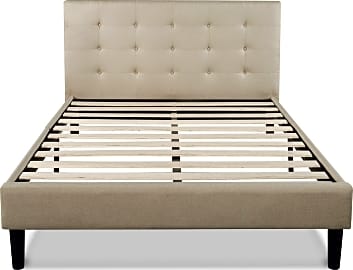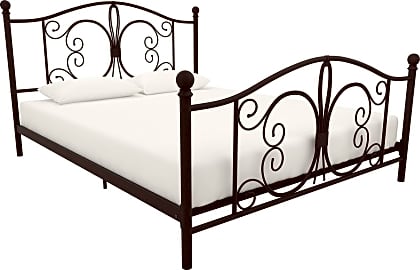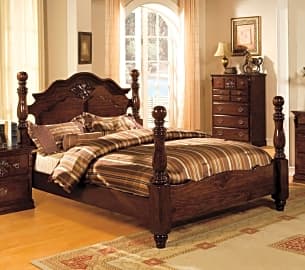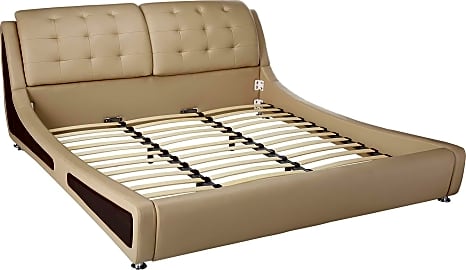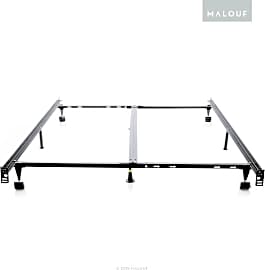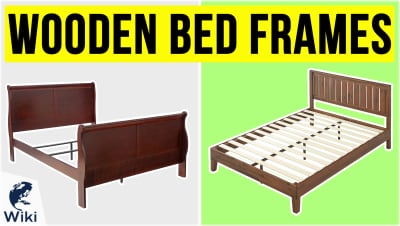The 10 Best Bed Frames

This wiki has been updated 33 times since it was first published in January of 2017. The key to a good night's sleep is a proper foundation for support, but your furniture should also complement your bedroom decor. One of these bed frames should satisfy both of those criteria. We've selected various styles, including elegant models with posts, and some platform options that eliminate the need for a box spring and can be used with just a mattress. When users buy our independently chosen editorial picks, we may earn commissions to help fund the Wiki.
Editor's Notes
April 09, 2019:
If you're looking for a traditional frame, the Leggett & Platt Doral and DHP Bombay are both simple options with elegant curved spindles on their headboards and footboards, and they're also affordably priced. The Malouf Adjustable has sliding rails that can accommodate any mattress size, and it comes with universal brackets that will allow you to add a headboard if you'd like. The 24/7 Shop at Home Poster is a classic model with ornately carved details on the posts and headboard. It's a great choice for those who prefer a fancier old-fashioned style, and the dark glossy finish will complement most color schemes, but it is pricier than most of our other selections due to its solid wood construction.
If you don't want to worry about a box spring, a platform bed will provide a sturdy foundation for your mattress with no additional support needed. The Sleep Revolution Platform Best and Container Direct Eastern are both low-profile options with upholstered headboards that are soft enough to lean back against while reading or watching TV in bed. The Novogratz Kelly is great for those who need extra storage space, with four large built-in drawers for clothing, shoes, bedding, and more. The Best Price Mattress Model H is a minimalist frame made from durable steel, and it's easy to set up and take down in just a few minutes, making it perfect for dorm rooms.
A Brief History Of Beds
A few centuries later, the ornamentation of the wood fell out of favor, replaced instead by luxurious materials like silk and velvet.
The first bed was likely invented when a caveman realized that lying on some leaves was preferable to flopping down on cold, hard rock. He soon introduced this new concept to other cavemen, who began experimenting with high-tech materials like animal skins and straw.
There were a few problems with this kind of bedding, however. The biggest was that it didn't get you off the ground at all, leaving you vulnerable to pests, drafts, and jagged rocks.
Around 3600 B.C.E., people in Africa began to raise their beds off the ground, using stone that they topped with leaves. Later, the Egyptians would have their beds placed atop small staircases, surrounded by curtains.
The Romans pioneered the use of mattresses. They stuffed theirs with hay, wool, and eventually feathers, and the mattresses were then placed inside elaborate beds made of bronze and silver. They actually had different beds for different purposes, including dedicated beds for sleeping, eating, studying, and, um...married people stuff.
By the 12th century C.E., beds were largely made of highly ornamented wood. Folding models were even available, and these often did double duty as couches during the day.
A few centuries later, the ornamentation of the wood fell out of favor, replaced instead by luxurious materials like silk and velvet. The four-poster bed made its debut around this time, and it used double curtains to shut out all drafts.
Beds took on incredible importance in the 17th century — so much so, in fact, that it's been described as "the century of magnificent beds." Most beds were incredibly lavish productions, and the number and quality of your cots was seen as a clear indicator of your station in life.
Dedicated bed frames started to appear after the Industrial Revolution. At first these were made of wood, but they were quickly supplanted by iron and steel, which were sturdier and less likely to harbor pests. Also making its debut around this time was the spring mattress, invented by a man named Samuel Kettle.
Mattress innovation would pick up steam in the 20th century, with latex, memory foam, and even water being used as sleeping surfaces. Having a warm, comfy bed was seen as a right instead of a privilege, and people were willing to pay premium prices for the ability to get a good night's sleep.
So far, the 21st century has seen an explosion in internet-based mattress companies, each of which promises to give you unparalleled sleep. Whether they can live up to that promise — and whether the market can support dozens of mattress companies — remains to be seen.
Choosing The Right Bed Frame
Finding the right frame is the first big decision you'll make in your bed-buying process.
The initial thing you should take into consideration is how big you want your bed to be. If you already have a mattress that you're committed to (and your relationship with your bed should supersede all other relationships in your life), then it's simply a matter of finding a frame that matches.
The good news is that buying a bed frame is hard to screw up.
If not, though, figure out how much space you can dedicate to your bed. Get out a measuring tape and determine the exact dimensions of your bedding area, and then use that to figure out the size of your frame. Don't forget to take into consideration how much room you'll need in the bed itself, especially if you're sharing it with a partner or, more importantly, several dogs.
The next big decision is whether to go with a box spring or a platform bed. Platforms are usually cheaper and easier to set up, but they also tend to be lower to the ground than many people like. Also, platforms are firmer than box springs, so take that into consideration if you like a soft sleeping surface.
Certain mattresses will require specific frames, as well. Many air mattresses, for example, need to rest on completely flat surfaces, so any frame with slats will be out.
Finally, decide on what you want it to look like. This includes the material — wood, metal, finely-polished whalebone, etc. — but also the accessories. Do you want a headboard? What about built-in storage? These are all things to think about.
The good news is that buying a bed frame is hard to screw up. Just remember: even in the worst-case scenario, you're going to end up with a bed. A beautiful, wonderful, inviting bed.
How Much Difference Does A Frame Make, Anyway?
When it comes to beds, mattresses are usually the glory hogs while frames toil away, unappreciated, in the trenches. But is that fair? How important is a good frame, anyway?
Short answer: very important. After all, your mattress has to rest on something, and that thing plays a big role in the quality of your sleep.
If you don't have enough support in the middle, the bed will sag, your mattress will become misshapen, and you'll feel like you've been sleeping at the bottom of a hill.
A good frame offers plenty of center support. This is especially important for larger beds. If you don't have enough support in the middle, the bed will sag, your mattress will become misshapen, and you'll feel like you've been sleeping at the bottom of a hill.
If you get a sturdy model, it won't move when you toss and turn. That makes it less likely that you'll wake yourself up, or worse, wake your partner up (because that's a good way to get murdered). Depending on the material, you might also be able to spare yourself from a lifetime of creaking noises every time you move.
Granted, your frame won't make as big a difference as your mattress or your sheets, but there's no reason to cut corners on this purchase. Keep in mind that you're going to spend a third of your life in bed, so try to buy one that forces you to spend the other two-thirds longing for it.


